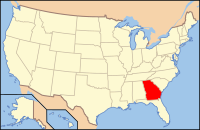Glynn County
| Glynn County, Georgia | |
|---|---|

Glynn County Courthouse
|
|
 Location in the U.S. state of Georgia |
|
 Georgia's location in the U.S. |
|
| Founded | 1777 |
| Named for | John Glynn |
| Seat | Brunswick |
| Largest city | Brunswick |
| Area | |
| • Total | 585 sq mi (1,515 km2) |
| • Land | 420 sq mi (1,088 km2) |
| • Water | 165 sq mi (427 km2), 28.3% |
| Population | |
| • (2010) | 79,626 |
| • Density | 190/sq mi (73/km²) |
| Congressional district | 1st |
| Time zone | Eastern: UTC-5/-4 |
| Website | www |
Glynn County is a county located in the U.S. state of Georgia. As of the 2010 census, the population was 79,626. The county seat is Brunswick. Glynn County is part of the Brunswick, Georgia Metropolitan Statistical Area.
Glynn County, one of the original eight counties in the state created on February 5, 1777, was named after John Glynn, a member of the British House of Commons who defended the cause of the American Colonies before the American Revolution.The Battle of Bloody Marsh was fought in Glynn County. James Oglethorpe built Fort Frederica which was used a base in the American Revolutionary War. Glynn Academy is the second oldest school in Georgia.
Glynn County includes the most prominent of the Sea Islands of Georgia, including Jekyll Island, St. Simons Island, and Sea Island. The Georgia poet Sidney Lanier immortalized the seacoast there in his poem, "The Marshes of Glynn", which begins:
The former Glynco Naval Air Station, named for the county, was a major base for blimps and anti-submarine warfare during World War II. The Federal Law Enforcement Training Center (FLETC) now uses a substantial part of the former NAS as its main campus.
...
Wikipedia
